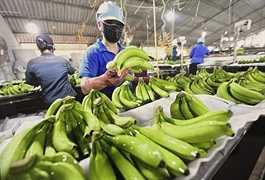Gold market rejuvenation on horizon
Gold market rejuvenation on horizon
Beyond identifying physical gold bars or establishing a gold exchange, fresh proposals have gone further, including the introduction of securities-like accounts at banks and gold trading enterprises.
On July 15, the State Bank of Vietnam (SBV) submitted a draft decree amendment on gold trading management, following a period of public consultation that has opened up a new approach. The market is now awaiting official information on upcoming changes in gold market regulation.

Gold market rejuvenation on horizon |
The policy of liberalising the gold market has gained broad support from the community. However, the current draft still leaves several fundamental policy design issues unresolved, particularly concerning licensing criteria and market regulatory mechanisms.
The draft imposes strict conditions on enterprises and commercial banks wishing to participate in gold bar production. Notably, the minimum charter capital requirement is set at $40 million for enterprises and $2 billion for commercial banks, thresholds that have sparked considerable debate.
Experts caution that if only a limited number of entities are licensed, the gold market structure may see little substantive change, contrary to the original liberalisation goals. Significantly, the draft lacks clear criteria for quota allocation and licensing for raw gold imports, which are crucial for ensuring transparency and fairness among market participants.
Dao Xuan Tuan, director general of the SBV’s Foreign Exchange Management Department, noted that approximately 6,000 businesses currently operate in the gold jewellery and fine arts sector, the majority of which are small-scale and reliant on domestic raw gold sources.
“To address this, the draft decree proposes a licensing framework allowing qualified enterprises and banks to produce gold bars and import raw gold for the production of gold bars and jewellery. This regulation is expected not only to expand raw gold supply but also to enhance competition in the gold jewellery market,” he added.
Leading gold businesses have commented that with today’s widespread application of technology across financial services such as e-lending and e-guarantees, enabling gold transactions through electronic platforms is both feasible and appropriate. Therefore, these institutions recommend including provisions on electronic gold trading in the decree, specifically through either a dedicated article or a regulatory principle under a current article.
Meanwhile, Agribank has proposed issuing ownership certificates to customers without requiring physical gold transactions. VietinBank also suggested that licensed credit institutions be allowed to delegate the execution of licensed activities, such as import-export and gold bar production, to their subsidiaries.
Conversely, the Vietnam Gold Traders Association opposed allowing credit institutions, especially commercial banks to engage in gold bar production and trading. The association argues this is inconsistent with the Law on Credit Institutions.
Regarding the draft, the Ministry of Public Security highlighted the absence of specific regulations on serial number tracking of gold bars in transaction documents, including for newly produced bars, reprocessed damaged bars, bars involved in trading, and bars converted into raw material.
Tran Huu Dang, general director of ASEAN Jewellery, said, “A gold account model would not only enable the SBV to monitor market supply and demand transparently, but also serve as a foundation for timely market interventions in case of volatility. This is a necessary step toward modernising gold trading in Vietnam, aligning with global financial market practices.”
While discussions on establishing a gold exchange have resurfaced, Vietnam previously experienced a speculative boom in gold exchanges. After ACB launched its gold exchange in 2007, other banks such as Eximbank, VietA Bank, and Sacombank followed suit. Yet, due to unregulated and distorted development, these platforms were shut down by late 2009, leaving lasting impacts on the market.
“To establish a gold exchange, the state would need a gold reserve and must standardise Vietnamese gold to international benchmarks. Vietnam could look to the Shanghai Gold Exchange as a reference. It is state-backed but operates on market principles with participation from banks and large gold enterprises,” said Dinh Tuan Minh, director of Market Solutions Research Centre for Social and Economic Issues.
Even after the draft decree was released, domestic gold prices remained elevated, with a premium of $4,788-4,848 per tael over global prices. Once again, scenes of customers lining up to buy gold have returned.
Prof. Dr. Tran Ngoc Tho, lecturer of the University of Economics Ho Chi Minh City, emphasised the need for a new mindset.
“Gold is not a problem to be managed but it is an asset that requires trust. We must build trust in legitimate asset classes,” he said. “The high premium between domestic and global gold prices is not the root problem but a symptom, reflecting weak confidence in alternative assets like stocks, bonds, real estate, or even the banking system and macroeconomic environment.”
Given that monetary policy is constrained by the mandate of inflation control, the SBV cannot always tap into foreign reserves to stabilise the gold market.
“Rather than using USD to prop up gold, the government should create a mechanism that turns gold into a psychological battery, an anchor of trust when the VND is under suspicion, without depleting forex reserves,” Tho added. “When we cannot generate power with USD, we must recharge trust via gold, using it as a buffer to absorb anxiety. This can be done through an FX buffer mechanism.”
- 09:00 31/07/2025



























